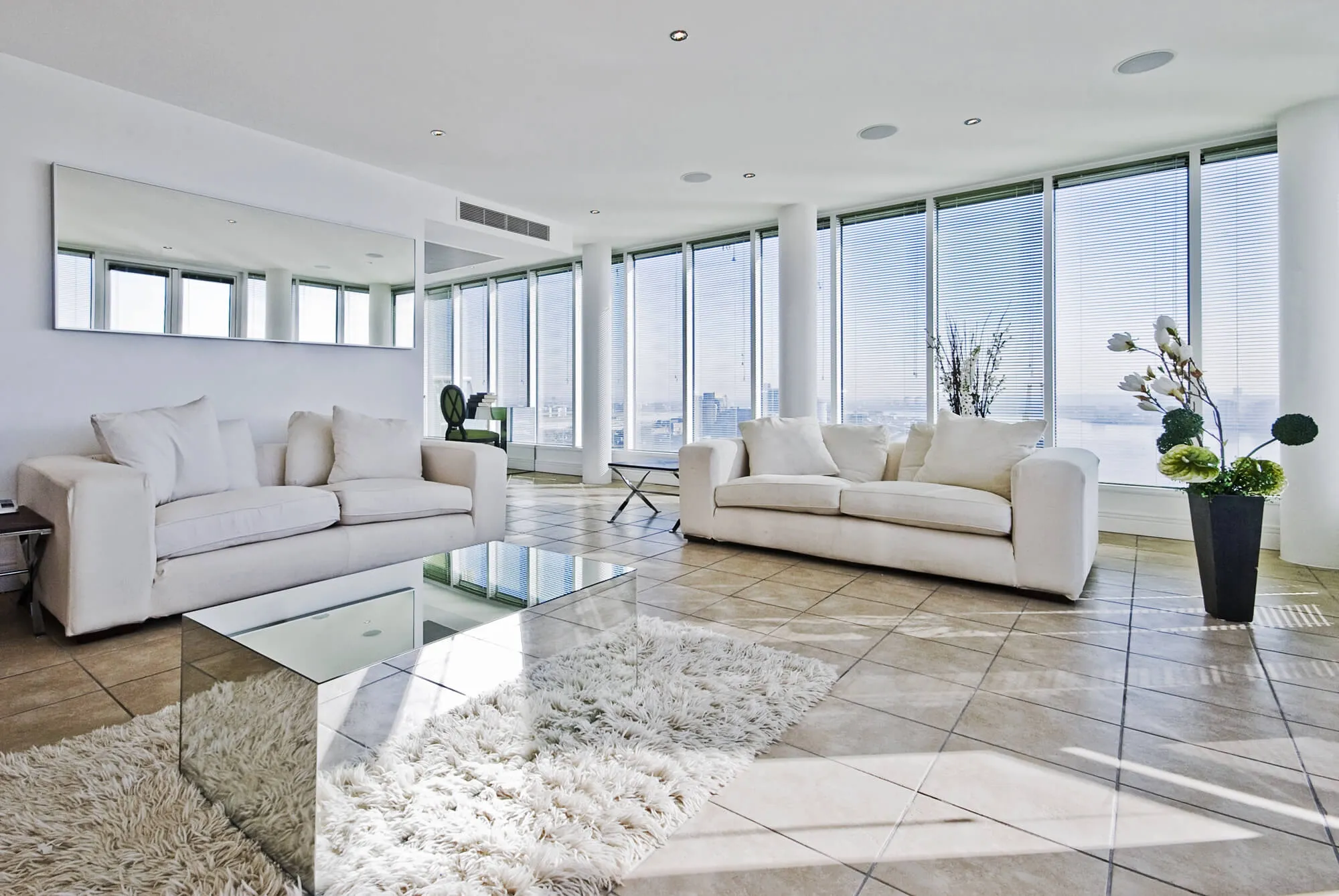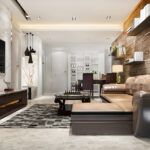Somewhere between traditional comfort and modern simplicity lies transitional design, a style perfectly suited for Florida home interior design. It balances clean lines with warmth, subtle luxury with livability. In a region where homes reflect both heritage and coastal ease, transitional interiors offer timelessness without feeling dated or overly ornate. Whether you’re in Palm Beach, Boca Raton, or Jupiter Island, this approach offers flexibility, elegance, and enduring appeal.

What Is Transitional Interior Design?
Transitional design bridges old and new, combining elements of traditional interiors like detailed millwork and classic furniture silhouettes with modern touches such as muted palettes, tailored fabrics, and minimal ornamentation. It embraces contrast but avoids extremes, offering refined sophistication that doesn’t feel cold or rigid.
Neutral Palettes with Depth
Color is key in transitional interiors. Think taupe, ivory, beige, soft white, and warm woods. These tones create an airy backdrop that suits Florida’s natural light. The layering of texture makes these palettes feel elevated: a matte limestone finish beside polished brass, a sisal rug against velvet upholstery.
Even within a neutral palette, there’s room for contrast. For example, you might see a dark-stained console table paired with ivory drapery or aged leather chairs with a pale wool rug. The goal is a balanced visual weight that draws the eye without overwhelming the space.
Furniture That Feels Tailored, Not Ornate
In transitional interiors, furniture takes inspiration from both sides of the design spectrum. Pieces may have traditional curves or profiles, but they’re executed in a simplified way. Look for structured upholstery, clean-lined frames, and thoughtful detailing such as a tapered leg or a piped edge that adds interest without dominating the room.
This style is perfect for open-concept homes in Florida. Sofas and chairs are scaled for comfort and conversation. Furniture arrangements encourage movement between indoor and outdoor spaces, making the layout feel natural and inviting.

Textiles That Layer Softly
Florida’s climate calls for breathable, light, and durable materials. Transitional design works beautifully with linen, cotton, brushed velvet, and wool blends. Window treatments might include sheer panels or relaxed roman shades in tone-on-tone fabrics.
Layering is essential, but never heavy-handed. You might combine a linen slipcovered sofa with a cashmere throw, or a tailored bedspread with a plush area rug. These details give depth to otherwise minimalist forms, creating a polished look that is not precious.
Art, Lighting, and Accessories
Transitional interiors lean on quality over quantity. Art tends to be large in scale, but restrained in color or subject. Framing is clean and deliberate. Lighting often includes sculptural chandeliers or sleek pendants, paired with classic wall sconces or table lamps.
Accessories are edited carefully. Think natural elements like stone bowls, ceramic vases, coffee table books, and layered trays. Even metallics are used sparingly—brushed gold, antique bronze, or polished nickel appear in finishes but rarely fight for attention.
Flooring, Millwork, and Architectural Detail
Much of the elegance in transitional design comes from its subtle architectural framing. Molding, wainscoting, and ceiling treatments often draw from traditional design but are applied with restraint. Flooring tends to be wide-plank oak, limestone, or honed marble—all materials that age well and keep interiors grounded.
These elements provide structure and context for the furniture and décor without overshadowing them. They also give transitional spaces a sense of permanence and craft that many Florida homeowners appreciate.
Why Transitional Style Works for Florida Homes
Florida homes present a unique blend of challenges and opportunities. They must balance indoor-outdoor living, withstand a bright and humid climate, and accommodate both formal entertaining and relaxed weekends. Transitional design meets all these demands with quiet confidence.
Light-Filled Spaces Benefit from Clean Lines
With abundant natural light in Florida homes, transitional interiors avoid glare and visual clutter by focusing on simplicity and flow. Muted tones reflect light softly, while layered materials prevent the look from feeling flat.
Versatility for Varied Lifestyles
Whether you’re designing a second home on Palm Beach Island or a year-round residence in Boca Raton, transitional interiors are adaptable. They suit both active families and design-forward individuals. This flexibility means your home can evolve without needing a full redesign.
Enduring Appeal
Trends shift quickly, but transitional style is grounded in balance. It feels current without leaning too far into minimalism or maximalism. That makes it an excellent choice for homeowners who value longevity and elegance without formality.
Creating a Transitional Look in Your Florida Home Interior Design
If you want to embrace transitional style in your Florida home interior design, start with the foundation: materials, proportions, and palette. A cohesive plan will help maintain consistency throughout the space without sacrificing creativity.
Begin with Architecture
Let your home’s structure guide your decisions. Honor its existing features by selecting furnishings and finishes that complement rather than contrast. In homes with arched windows or traditional baseboards, transitional furniture helps soften the formality without losing the charm.
Focus on Flow
Transitional design thrives in open layouts. Create subtle boundaries with area rugs, lighting, or millwork while allowing furniture arrangements to encourage movement. A well-placed console table or pair of chairs can define a zone without enclosing it.
Use Restraint with Color and Pattern
Stick to a limited palette and introduce visual interest through texture rather than busy prints. If using pattern, keep it tonal, such as a geometric weave in neutral tones, so it adds richness without distraction.
Invest in Quality
Transitional interiors value craftsmanship. Choose fewer pieces, but make them count. Well-tailored furniture, artisan lighting, and quality window treatments elevate the room and endure over time.
Edit Thoughtfully
Resist the urge to overfill. Let each piece have space to breathe. Leave negative space where possible and let materials speak for themselves. This approach brings clarity and ease to your design.

Transitional Style in Florida Home Interior Design
Transitional design is more than an aesthetic—it’s a practical and elegant way to live, especially within the context of Florida home interior design. It respects architectural detail, welcomes light, and embraces comfort without compromise. The result is a tailored, timeless, and livable space.
If you’re looking to bring this thoughtful style into your own home, Mayfair Workroom offers a full-service approach to interior design. Our team works closely with homeowners to create refined interiors that reflect your lifestyle and your Florida home’s architecture. Let us help you design a space where tradition meets modern living with quiet sophistication. Contact us today!




